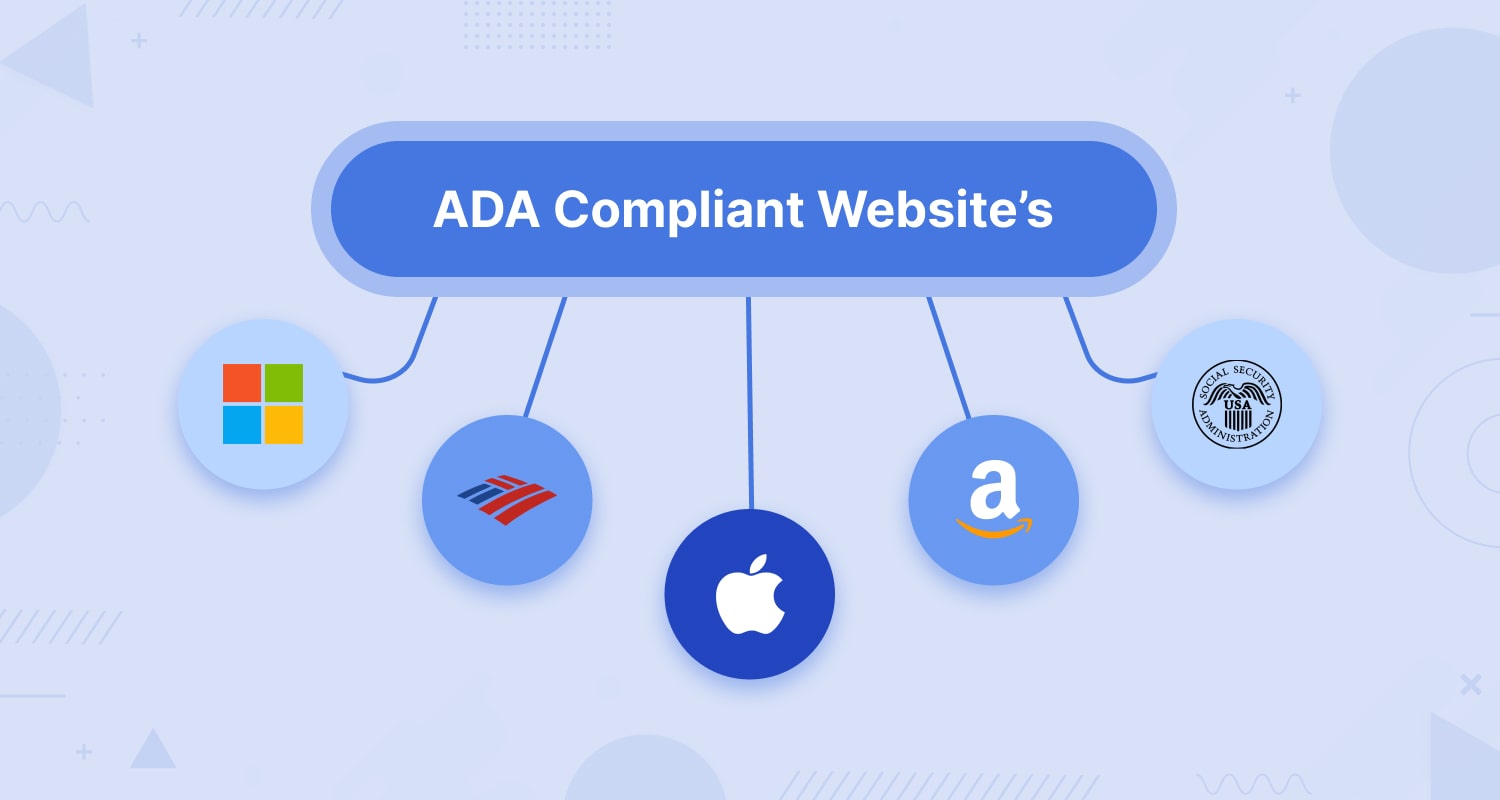Creating an ADA compliant website is more important than ever before. With the internet being a primary source of information and resources, it’s essential to make your website accessible to everyone, including people with disabilities. As a website owner, it’s your responsibility to ensure that your website is accessible and easy to use for everyone. If you’re wondering how do I make my website ADA compliant, this guide covers every aspect.
In this article, we’ll guide you through how to make your website ADA compliant. We’ll explore what ADA compliance means, why it’s important, and how you can make your website compliant. By following these tips, you’ll ensure that your website is accessible to everyone, regardless of their abilities.
How Does ADA Compliance Work?
ADA website compliance refers to making sure that a website is accessible to individuals with disabilities. The Americans with Disabilities Act (ADA) requires that websites be designed in a way that allows people with disabilities to access the content, navigate through the website, and interact with it. This includes ensuring that the website is compatible with assistive technologies such as screen readers and that content is presented in a way that is understandable for all users.
To test accessibility of website features, businesses can use a website accessibility test or ADA compliant website checker tools. These tools help identify areas that need improvement, offering actionable insights to boost compliance.
Is ADA Compliance Required for Websites?
Yes, ADA compliance is mandatory for websites, especially for those in the United States. As per the Americans with Disabilities Act (ADA), websites must be accessible to individuals with disabilities. Failure to comply with the ADA could result in legal action, including hefty fines and costly lawsuits.
Are you wondering – does your website need to be ADA compliant portfolio website or business platform? The short answer is yes — all public-facing websites should comply.
In recent years, the number of ADA-related lawsuits against websites has increased significantly. These lawsuits primarily target businesses and organizations whose websites are not accessible to people with disabilities. In response, web development services in India and other countries now offer ADA compliance WordPress services and custom ADA-focused web development.
An ADA compliant website checklist includes several key elements that must be included to ensure that the website is accessible to everyone. This includes providing alternative text for images, using descriptive headings, ensuring that the website is navigable using a keyboard, and providing closed captions for videos, among others.
While compliance with ADA guidelines is mandatory, it’s also essential for businesses and organizations to recognize the importance of making their websites accessible to everyone. By doing so, they can increase their reach, improve user experience, and prevent potential legal issues. In addition, an accessible website is a reflection of a business’s commitment to social responsibility and inclusivity.
For a quick evaluation, a website compliance checker can be used to spot violations of ADA requirements.
Why Is Website ADA Compliance Important?
ADA compliance is an essential aspect of website development and design. It is a set of guidelines that ensure that websites are accessible to all individuals, regardless of their physical or cognitive abilities. ADA requirements for websites mandate universal accessibility and legal adherence.
You may like this: How Much Does It Cost to Build a Website?
There Are Several Reasons Why ADA Compliance Is Important for Your Website
Increases Your Reach Lead Generation
By ensuring that your website is accessible to all individuals, you increase your reach and potential customer base. Almost a billion individuals around the world have a disability, according to the World Health Organization. This demographic represents a significant portion of the population, and ignoring their needs can mean missing out on valuable leads and potential customers.
To unlock broader opportunities, many businesses first run a website compliance checker to identify accessibility gaps before redesigning.
Improves Your User Experience
One of the primary benefits of ADA compliance is that it can significantly improve your website’s user experience. ADA approved websites are designed with accessibility in mind, which means that they are user-friendly for all individuals, regardless of their abilities. This includes features such as easy-to-read fonts, clear navigation, and keyboard compatibility.
So, if you’re thinking about how to make a website ADA compliant, start by assessing how intuitive and accessible your current design is.
Improves Your SEO Strategy
ADA compliance can also improve your website’s search engine optimization (SEO) strategy. This is because search engines prioritize websites that are easy to navigate and provide a positive user experience.
As you make a website ADA compliant, improvements such as semantic headings, alt text, and better metadata contribute directly to SEO.
Helps Prevent ADA-Related Lawsuits
Perhaps the most significant reason why ADA compliance is essential for your website is that it can help prevent ADA-related lawsuits. In recent years, there has been a significant increase in the number of lawsuits filed against websites that are not accessible to individuals with disabilities.
These lawsuits can result in significant legal fees, negative publicity, and even damages. By ensuring that your website is ADA-compliant, you reduce the risk of facing these types of legal challenges and protect your business from potential harm.
ADA compliance is an essential aspect of website development and design. It can help increase your reach and lead generation, improve your user experience, boost your SEO strategy, and help prevent ADA-related lawsuits. To ensure that your website is ADA-approved, it is recommended that you hire dedicated web developers who are knowledgeable about these guidelines and can help ensure that your site is accessible to all individuals. By prioritizing accessibility in your website design, you can create a positive user experience for all visitors and set your business up for success.
How to ADA-Comply with Your Website?

Making your website ADA compliant benefits both your users and your business. If you’re wondering how to make a website ADA compliant, focus on navigation, design, and content accessibility.
Website Navigation
Website navigation is a crucial aspect of making your website ADA compliant. It includes the use of clear headings, subheadings, and page titles to help users understand the content and structure of your website. Here are some tips for creating accessible website navigation:
- Use descriptive page titles: Page titles should accurately reflect the content on the page, making it easier for users to understand what they can expect to find.
- Use clear headings and subheadings: Headings should be descriptive and help users understand the structure of the page. They should also be in a logical order.
- Use skip navigation links: Skip navigation links allow users to bypass repetitive links, such as a navigation menu, and jump to the main content of the page.
- Use alt text for images: Alt text should describe the content of the image, making it accessible to users who use screen readers.
Design
Design is an essential part of making your website ADA compliant. It includes the use of clear fonts, colors, and layouts to ensure that users can easily navigate your website. Here are some tips for creating accessible website design:
- Use high-contrast colors: The use of high-contrast colors ensures that text is easy to read, making it accessible to users with low vision or color blindness.
- Use clear fonts: Fonts should be clear and easy to read. Avoid using tiny typefaces or fancy fonts.
- Use descriptive link text: Link text should accurately describe the content of the linked page, making it easier for users to understand where the link will take them.
- Use captions and transcripts for audio and video content: Captions and transcripts make audio and video content accessible to users who are deaf or hard of hearing.
Content
Content is another essential part of making your website ADA compliant. It includes the use of clear and concise language, alternative text for non-text content, and proper use of tables. Here are some tips for creating accessible website content:
- Use clear and concise language: Use clear and simple language to ensure that all users can understand your content. Avoid using complex words or jargon.
- Use alternative text for non-text content: Alternative text should describe the content of non-text content, such as images and videos, making it accessible to users who use screen readers.
- Use proper table structure: Tables should have proper headers and row and column labels, making it easier for users to understand the data presented.
- Avoid flashing or blinking content: Flashing or blinking content can trigger seizures in users with epilepsy. Avoid using this type of content on your website.
Making your website ADA compliant is essential for ensuring that all users can access and use your website. This includes website navigation, design, and content. How to create a web application that is ADA compliant, it is recommended that you hire dedicated developers who are knowledgeable about these guidelines and can help ensure that your website is accessible to all users. By prioritizing accessibility in your website design, you can create a positive user experience for all visitors and set your business up for success.
ADA Compliant Website Examples

An ADA compliant website is one that meets the guidelines set forth by the Americans with Disabilities Act (ADA) to ensure that individuals with disabilities have equal access to information and services. These guidelines include accessibility features for users who have visual, auditory, cognitive, or physical disabilities. Here are some examples of websites that are ADA compliant:
1. Microsoft
Microsoft is another example of a company that has made significant efforts to make their website ADA compliant. They use clear headings, high contrast colors, and keyboard navigation. They also offer closed captions for video content and alternative text for non-text content.
2. Bank of America
Bank of America is a financial institution that has made efforts to ensure their website is ADA compliant. They use clear headings and labels, high contrast colors, and alt text for images. The website is also compatible with screen readers, and they offer keyboard navigation for users who have physical disabilities.
3. Apple
Apple is an excellent example of an ADA compliant website. The company has made significant efforts to ensure that their website is accessible to all users. They use clear headings and labels, high contrast colors, and alt text for images. Apple’s website is also compatible with screen readers, and they offer keyboard navigation for users who have physical disabilities.
4. Amazon
Amazon is an e-commerce website that has made significant efforts to ensure their website is accessible to all users. They use clear headings and labels, high contrast colors, and alt text for images. Amazon’s website is also compatible with screen readers, and they offer keyboard navigation for users who have physical disabilities.
5. The United States Social Security Administration (SSA)
The United States Social Security Administration (SSA) is a government agency that has made significant efforts to ensure their website is ADA compliant. They use clear headings and labels, high contrast colors, and alt text for images. The website is also compatible with screen readers, and they offer keyboard navigation for users who have physical disabilities.

How Our Experts At CMARIX Can Help
At CMARIX, our developers specialize in building ADA compliant websites across platforms. Whether you’re starting fresh or improving an existing website, we follow WCAG standards, perform audits with ADA compliant website checker tools, and build fully accessible user interfaces. Contact us today to hire MEAN stack developer and get started on your project.
Whether you’re using WordPress or a custom stack, we make your ADA compliance WordPress project meet the required benchmarks.
Conclusion
ADA compliance is essential for creating a website that is accessible to all users, including those with disabilities. From using a website compliance checker to implementing the right design and content strategies, it’s easier than ever to build with inclusivity in mind. Hire dedicated developers to ensure your ADA compliant website is not only functional but impactful.
Frequently Asked Questions
How can you get your WordPress Site ADA Compliant?
Ensure that your website meets the accessibility guidelines outlined in the Web Content Accessibility Guidelines (WCAG). Use an ADA compliant website checker to identify violations and align your site with WCAG guidelines.
Is Your Website ADA Compliant?
Run a website accessibility test to find out. It’ll show if your site meets the necessary standards.
Is ADA Compliance Mandatory for Websites?
Yes, compliance with ADA requirements for websites is legally enforced under U.S. law.
What Features Do ADA-Compliant Websites Have?
They include accessible layouts, screen reader compatibility, closed captions, alt text, and keyboard navigation.







